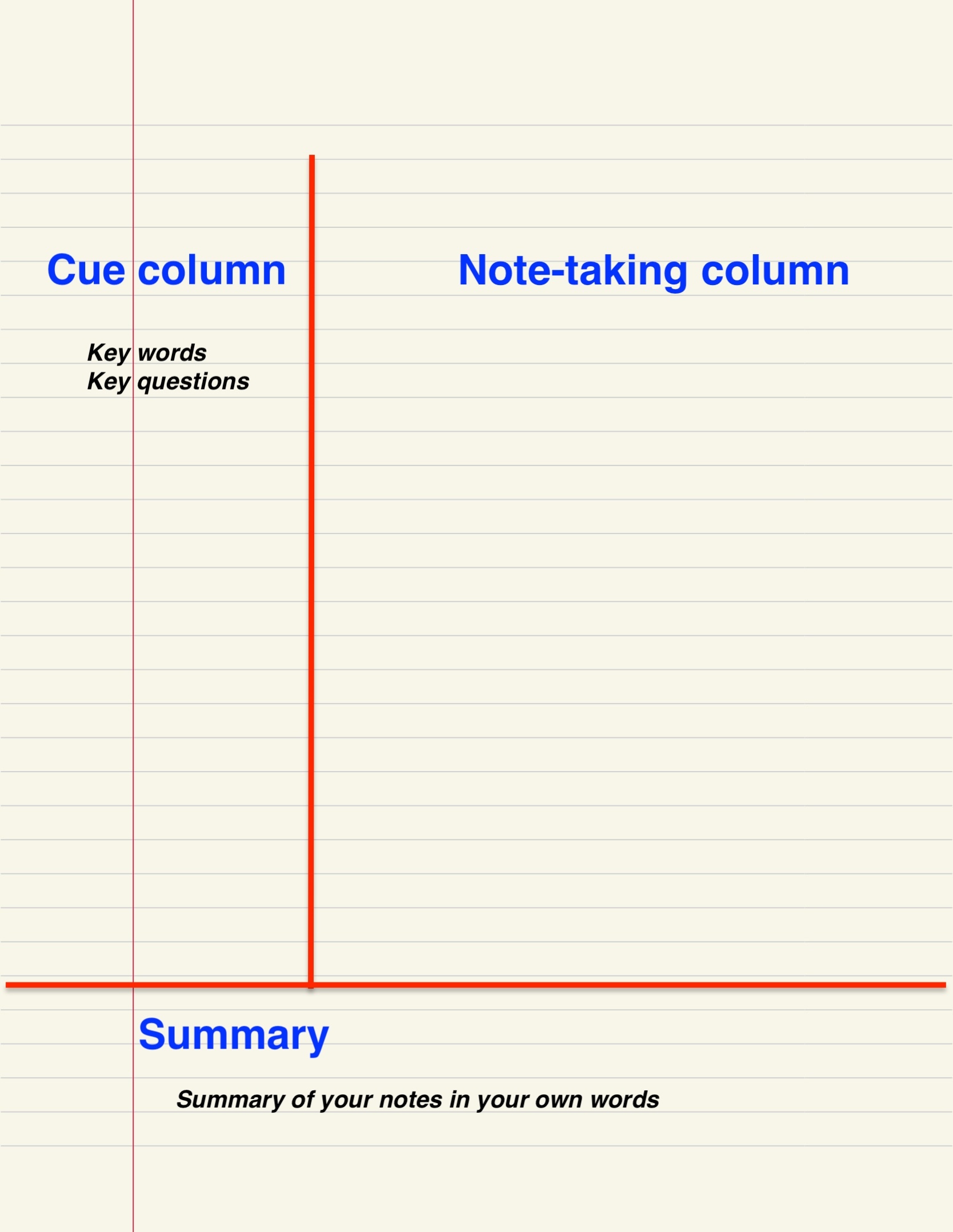Chapter 1: Note-taking Strategies
Note-taking Skills
 What makes notes “good” notes? What makes someone a “good” note-taker? Notetaking is a skill you can practice, and there are several different approaches you can take to recording your notes for class. Keep reading to understand each note-taking strategy.
What makes notes “good” notes? What makes someone a “good” note-taker? Notetaking is a skill you can practice, and there are several different approaches you can take to recording your notes for class. Keep reading to understand each note-taking strategy.Why take notes?
Before we can talk about taking better notes, we need to understand why notes are important. Can you think of some reasons it might be important to take notes?
-
Notes can help you remember what you learned.
-
Notes will be useful to review for a test or discussion.
-
The act of writing notes can help improve comprehension and increase the likelihood you’ll remember the ideas later.
-
You can revisit complex ideas or ideas you didn’t understand and clarify them later.
How to take good notes
-
Organized – use space and keep similar ideas together. Make it clear when you’ve changed to a new idea.
-
Highlighted – this doesn’t necessarily mean using a highlighter; it means making key words and ideas stand out.
-
Concise – notes should be brief but accurate. This might mean writing down clipped versions of what your teacher says and writing in fragments of ideas instead of complete sentences.
-
Detailed – while your notes should be concise, they should also have enough detail so you can review them later. You need to include terms and definitions as well as explanations. You may have to practice writing faster so your notes can be as concise and detailed as needed.
-
Bullet points
-
Numbered lists or Outlines
-
Color or Visuals
-
Color coding
-
Symbols
-
Questions
Cornell Notes
The Cornell Note-Taking System is a structured note-taking method designed to help us efficiently record, organize, and review study materials. It promotes active engagement with the material and supports effective learning and retention.
Cornell notes have several benefits. First, they help keep notes neat and systematically arranged. It is easier to find what you are looking for if you have a consistent system. Additionally, taking Cornell Notes promotes active learning because you have to think through things in order to organize ideas and sum up in your own words. It doesn’t allow you to just read or listen passively. This active engagement makes you more likely to remember the material. Cornell Notes also provide you with a solid way to review material. Finally, the system is adaptable. It works for taking lecture notes or notes from reading material, such as textbook chapters and research articles. You can make make the system work for you by color-coding, using symbols (✔,❗,⭐), drawing pictures, or taking notes digitally.
How to Take Cornell Notes
-
Divide your paper into 3 sections as shown above.
-
The Cue Column: This narrow column is where you break down the notes into subtopics. These can be key terms, questions, or elements of the main notes.
-
The Note-taking Column: The main section on the right-hand side is for detailed notes.
-
The Summary Area: The bottom of the page is for a brief summary of notes in your own words.
-
-
During the Lecture or Reading:
-
- First, at the top of the page, label the notes with the name of the class,the date, and most importantly, the topic of the notes. This is key for knowing what the notes are about at a glance and which notes are for which class,
-
In the note-taking column, write notes on the main points, facts, and details of the reading or lecture.
-
Use short phrases, bullet points, or diagrams to capture information quickly.
-
Leave space between topics for easier review later.
-
-
In the cue column, write keywords, questions, or prompts based on your notes in the note-taking column. These should help you recall the content or “trigger” deeper thinking.
-
In the summary area, sum up the key points from the page in your own words. Keep it short (1-2 sentences).
-
Quadrant Notes
 Quadrant note taking is another system of notes that many people find to be an organized way to take notes and that can apply to many different scenarios in which you might take notes.
Quadrant note taking is another system of notes that many people find to be an organized way to take notes and that can apply to many different scenarios in which you might take notes.
To take notes in quadrant form, you can follow a few simple steps to make sure your notes are organized and effective. First of all, you need to have an idea what you will be taking notes over that day. Coming to class prepared for what you are going to learn is a great way to start. Next, when you are getting ready to take notes, divide your paper into at least 4 quadrants. You can divide your paper into more sections if that is more logical for what you will learn that day. As you are taking notes, you need to stick to one big concept or a few related concepts per quadrant. The point of quadrant notes is to keep your notes as simple and organized as possible. After you’ve taken notes and kept them organized, it is always good practice to review your notes and make sure they are clear and accurate so you can use them to study and improve your memory of the ideas you learned.
Outline Notes
When our notes are more complex with more layers to the ideas, we might need a more advanced approach to taking notes. Taking notes as an outline may seem daunting if you aren’t used to taking notes—especially taking complex notes. But taking notes in outline form is a great way to keep all the ideas organized and easy to study.
-
Start with the main topics. These are the big ideas that your teacher will emphasize as you go through the class. Write down the main topics on the line closest to the left side of the page. You can use Roman numerals or numbers for each topic.
-
Add subtopics, examples and explanations. When your teacher emphasizes a major idea, they will usually expand on that idea with definitions, subtopics, explanation, and examples. It is important for you to write down as much as will be helpful when you study them later. Subtopics should not touch the left side of the page, but should be indented or closer to the middle of the page. You can use letters or numbers for each subtopic.
-
Use symbols and abbreviations. In order for you to get all the important things in your notes, you won’t be able to write in complete sentences or long responses. Keep your points short and concise. Use symbols or abbreviations to help you write faster and keep your ideas clear.
-
Review and revise your notes. You may miss things while you’re taking notes during class. That’s okay—as long as you go back after class and add in the details you may have missed. You can follow up with the teacher for missing details or ask a classmate to review notes with you.
-
Other additions: you can also add color, highlighting, symbols, or diagrams to your notes to enhance them and add clarity.
Example Outline
The most important thing about outlining is using levels to keep the information organized:
- First key point goes here
- Explanation of key idea goes here.
- This might be another clarifying detail or example.
- Next point goes here
- More explanation
- Keep adding levels as needed to clarify the explanation
- Indented notes means it is giving additional, more specific information
- More explanation
-
- More details about the 2nd point go here
3. Next point goes here
-
- Explanation
Practice 1.1
Note-taking Review
| active | annotating | Cornell | indented |
| organized | outline | quadrant | summary |
Attributions
Strengthening Reading and Comprehension by Audrey Cross and Katherine Sorenson is licensed under Creative Commons Attribution-NonCommercial 4.0 International
Media Attributions
- Photo of Note-taking by Prophsee Journals on Unsplash © Prophsee Journals
- Cornell note system © WikiLinuz is licensed under a CC0 (Creative Commons Zero) license
- Quadrant Notes © Shelley Decker
(kən-sīce), adj.
Expressing much in few words; brief and clear.
(kyoo), n.
A signal or prompt for someone to do something.
(kwŏd-rŭnt), n.
One of four equal sections into which a plane is divided.
(out-līn), n.
A general description or plan giving the essential features of something.

